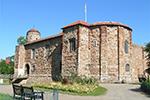Believed to be one of the oldest settlements in the UK, Colchester is a town bursting with history.
During the Roman era, the Essex settlement began life as a fortified military camp before it was named a provincial Roman capital of Britain.
In 2004, the remains of a chariot racing track were found under the local army barracks, while a collection of Roman jewellery, known as the Fenwick Hoard, was discovered during excavations beneath Williams and Griffin department store 10 years later.
Today, Colchester has a population of around 122,000 people and is a popular commuter town given its proximity to London.
‘Colchester is a really good place to be and it’s a lovely town to work in,’ says Nick Hagan, one of three directors at Specsavers Colchester. Hagan manages a large team of around 60 employees and believes the town is ‘blessed’ to have a proactive Local Optical Committee (LOC) that offers a Mecs, GRR and paediatric scheme.
With a ‘huge’ patient base, the practice currently operates with eight consultations rooms, but there are plans to increase this number to 14. Technology is another area where Specsavers Colchester is developing. In February 2016, the store got a Topcon Maestro OCT-1, making it the first practice in the town to own an OCT. ‘We invest heavily in all aspects of the practice, ensuring all our team work with the latest and best equipment,’ adds Hagan.
Clive Roots, a partner at Owen Aves Opticians, says ‘Colchester is a very vibrant university town with an active arts scene.’ Roots has been working in optics for 30 years and joined the practice eight years ago after having previously worked in South Essex.
The company comes from a rich heritage with Owen Aves – founder of the practice established in 1957 – believed to have fitted the very first progressive lens. Maintaining the same high quality of service, the independent practice treats patients of all ages from small infants to seniors.
Roots explains that the majority of his patients are 50 years or older; something which he believes is ‘indicative’ of modern independents. As a result, the partner and his colleagues treat an array of conditions.
‘The practice has got a reputation for being a bit of a specialist for people with eye problems. My previous partner Richard, who passed away a couple of years ago, started up a self-referral service with the local GP some 10 or 15 years ago, so we have a tradition of seeing more complicated cases,’ says Roots.

Located on the edge of town is Asda Opticians Colchester. Martin Hogg, optical manager (pictured), says there is a demand for the latest frame deigns due to a large student population. But convenience is a crucial factor. ‘Our clinics are very popular with children after school and at the weekend when parents like to do their shopping in store and combine this with an eye check,’ he said.
Who’s in town
Total: 10
Independents: 4
Multiples: 6
Average costs
The price of an eye exam in Canterbury ranged from £19 to £40, producing an average cost of £24.02.

Population
Colchester City 119,441 (ONS 2011)
Community eye care
According to the Locsu Atlas Map of Optical Variation, Essex Local Optical Committee has secured a contract for North East Essex CCG in Glaucoma Referral Refinement, Minor Eye Conditions Service and Children’s Vision.
Health and affluence
- The average house price in Colchester is £315,639 (Zoopla) compared with a UK average of £223,257 (Land Registry, 2017)
- Colchester’s average salary is £23,708 (PayScale, 2017)
- In 2015, there were 3,650 people living with diabetic retinopathy in Colchester (RNIB Sight Loss Data Tool 2015)
- It is estimated that, by 2020, there will be 8,100 people living with Drusen, an early stage age-related macular degeneration (RNIB).
- By 2025, it is estimated that there will be 1,830 people in Colchester who suffer from glaucoma (RNIB).
Fact file

In Roman times, Colchester was known Camulodunum.
The Essex town has the largest surviving Roman gateway in Britain. It was built to defend Colchester after the Boudican rebellion in AD60.
The largest surviving Norman keep in Europe can be found in Colchester. Colchester Castle, pictured, is a Grade I listed building and is built on the foundations of the earlier Roman temple of Claudius.
A major earthquake struck Colchester in 1884.
